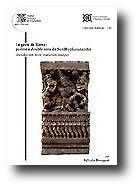La geste de Rama
Sandhyākaranandin (12 Jh.):
La geste de Rāma : poème à double sens de Sandhyākaranandin / introduction, texte, traduction, analyses [par] Sylvain Brocquet. - Pondicherry : Institut français de Pondichéry ; Ecole française d'Extrême-Orient, 2010. - vii, 522 S. - (Collection Indologie ; 110)
Einheitssachtitel: Rāmacarita <Sanskrit, franz.>
ISBN 978-2-85539-676-7
Rs. 1000,00
EUR 43,00
DDC: 891.21
Beschreibung
The Rāmacaritam by Sandhyākaranandin, a narrative poem of 215 stanzas (of which 215 survive), is a perfect example of poetry with two meanings: by constant use of śleṣa, it contrives to summarize the plot of the Rāmāyaṇa and to relate the recovery of Eastern Bengal, during the eleventh century AD, by Rāmapāla, a ruler of the Pāla dynasty. The last chapter extends beyond the martial story and deals with the succession of the epic hero and of the historical king. Some thirty stanzas add a third meaning, of theological character, to the two main ones.
This book provides the Sanskrit text transliterated (the transliteration is duplicated to reveal the different morphological analyses), a separate translation of each meaning, and a close analysis of polysemous sequences. An introduction sheds light on the literary and historical context on the one hand, on the linguistic and rhetorical devices which generate polysemy on the other hand. The book is complemented with several appendices containing: another famous literary example of double entendre, a list of known inscriptions issued by the rulers who are referred to in the poem, and the text and the translation of one of the main epigraphs. Two indices record all the polysemous words and all those of historical or geographical purport. [Verlagsinformation]
Herausgeber/Übersetzer
SYLVAIN BROCQUET a fait conjointement des études d’indianisme et de Lettres Classiques. Allocataire de l’Institut Français de Pondichéry entre 1992 et 1994, il a publié une thèse intitulée Les inscriptions sanskrites des Pallava : poésie, rituel, idéologie (Lille, Presses du Septentrion, 1997). Il est actuellement professeur de linguistique comparée des langues anciennes à l’Université de Provence. Il publie des articles portant sur l’épigraphie sanskrite de l’Inde, sur la poétique et la littérature savante de langue sanskrite. Il a également collaboré à la traduction de corpus littéraires chez Gallimard (théâtre, contes), et participe à plusieurs projets de recherche (épigraphie du Bengale, de l’Inde du Sud), dans le cadre de différentes institutions : Maison de l’Orient (Lyon), Institut Français de Pondichéry, Ecole française d’Extrême-Orient.
Quellen: École Française d'Extrême-Orient; UMR 7528 - Mondes iranien et indien
Ähnlich
- Deokar: Subhuticandra's Kavikamadhenu on Amarakosa
- Knutson: Into the Twilight of Sanskrit Court Poetry
- Patel: Text to Tradition
- Puspika 2
- Puspika 1
- Balbir: Le Sanskrit
- Leclère: Le théâtre de l'Inde médiévale entre tradition et innovation
- Sivasvamin's Kapphinabhyudaya
- Illustrated Rajatarangini
- Mpu Monaguṇa's Sumanasāntaka

